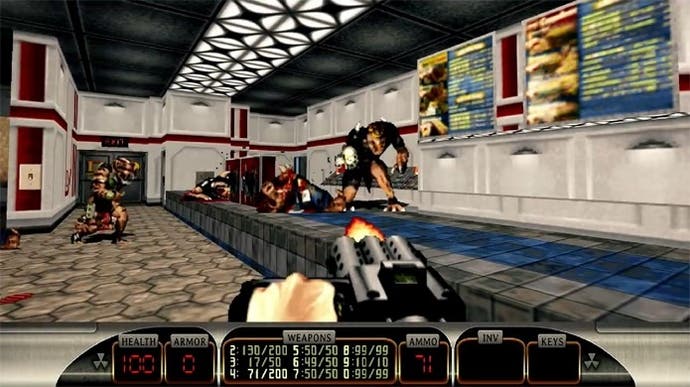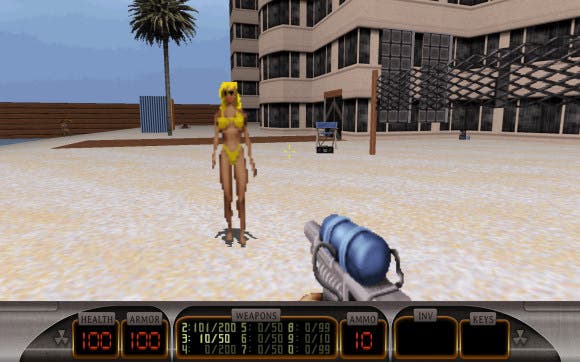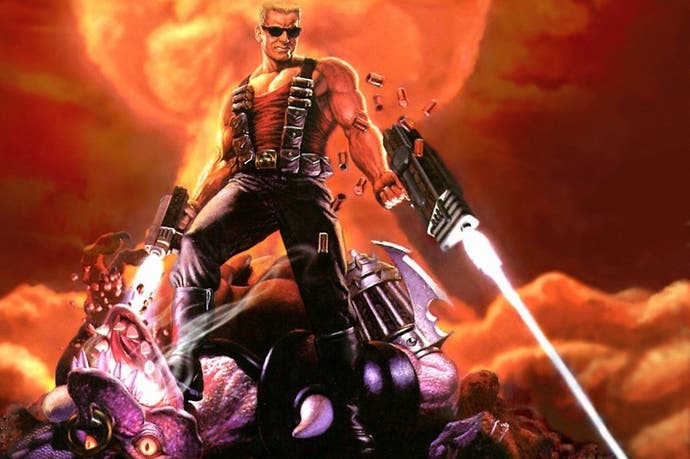How Duke Nukem 3D managed to be ahead of its time while trapped in the past
Up and atom.
I've lost track of how many times I've played through the opening chapters of Duke Nukem 3D. It's a game that still delights me today, over 20 years since its original release, and also a game that makes me cringe with embarrassment for the easily amused adolescent twerp I was. It somehow still manages to represent both the best of what games can be, and the worst of gaming's lazy vices.
Back in 1996, when it was still necessary to append "3D" on the end of a title so people knew to expect polygons, Duke Nukem hit the FPS genre like an atom bomb. Following indecently close behind the mould-breaking Doom, it ushered in not only an era of proper solid 3D game worlds, but showed that those worlds could be funny as well as fun, and deserving of exploration for reasons beyond another colour-coded keycard.
Where Doom offered a series of mazes hewn from brushed metal and bright red rock, Duke Nukem 3D offered a recognisable facsimile of the real world. Admittedly, it was a version of the real world populated mostly by strippers and toilets, but those first few levels were an absolute revelation at the time.

I was working on an internet magazine in 1996, and still remember the stunned conversation in the pub at lunchtime after we'd downloaded the shareware demo of Duke on an office PC. Light switches that worked! Toilets that you do a wee in! Mirrors that reflected your character! A movie projector that played an actual movie (or a pixellated looped animation of a woman enjoying herself rather a lot)! Everyone wanted to take turns poking around with the demo, just to see what we could find and do.
That first level - charmingly titled Hollywood Holocaust - was an absolute treasure trove of interaction and environmental feedback, and one that rewarded curiosity. Even playing through those stages again, courtesy of the generous Duke Nukem 3D: Megaton Edition that's recently come to PlayStation Vita and PS3, I'm still amazed at just how much stuff there is to find and do in this game. Even some of the secret areas have secret areas.
It's a nice fit with the Vita, too. Certainly, the crisp but smaller screen is kinder to the chunky graphics than a giant HD TV, although the difference between the polygon environments and the flat sprite characters looks weirder than ever. Control is a little slippery, having been designed for inputs far less nuanced than we're used to today. There are some nice additions though, such as using the front touch screen to swap weapons. The odd fish-eye effect that earlier versions of the Megaton Edition suffered from has been largely eradicated. Some other default settings are harder to appreciate - duck on the triangle button? - but it shows that Duke was a game that could transition surprisingly well across platforms and decades.
What has aged less well is Duke's bawdy nature, which comes to the fore in the game's second stage, Red Light District. For all my excitement in 1996 at the game's technical and design innovations, I'm ashamed to say that I never thought anything of the crudely animated strippers who expose their tassled breasts at the press of a button, or the sticky, smutty nature of a world where literally everything seems related to sex - from the shops to the cinema to the nightclub - or at least the puerile naïve version of sex that plays so well for teenage boys.

Such moments don't make me howl in outrage, but they do make me roll my eyes at what passed for wit in 1993. It's lowest common denominator stuff, but I'm glad it hasn't been cleaned up for this re-release. There should always be room for art - and, bone-headed as it is, Duke Nukem 3D is a creative work that warrants the a-word as much as anything else - that is dumb, or gross, or offensive. I've got shelves of old VHS tapes of grotty horror and exploitation movies whose only reason for existing is to be as disgusting as possible. I long since outgrew the ability to take pleasure in them, but they serve as a time capsule of sorts.
I feel the same about Duke's sticky-palmed aesthetic, which is simultaneously pathetic and almost endearingly naïve. I view it through much the same lens as the casual racism and homophobia that permeates 1980s action movies, or the gratuitous sex scenes in a well-thumbed horror paperback from the same period. So much of Duke is parody, yet the women aren't. Duke is a caricature. His enemies are literal cartoons. Yet the passive females are notably realistic, created from digitised photographs and video loops that could have been ripped from any porn mag or stag reel. They're interactive scenery objects with pixel boobs.
It's literal objectification, open and unashamed of its prurience. It's a museum piece, not just of how blatantly sexist games used to be, but of how blind to that I was as a young man. And that's important. I'm glad that the same game that reminds me of how amazing those early 3D game worlds could be is also one that reminds me that both the industry and I still had a lot of growing up to do.

That's why the attempts at the same tone in Duke Nukem Forever fell so flat. It's one thing when a piece of entertainment reflects the mores of its era, only to look grotesque in hindsight. It's another entirely for a modern retread of that material to co-opt the same mores purely for effect. It actually feels worse because its not even sincere in its old fashioned views. It's why the Carry On movies still hold a nostalgic charm, while Sex Lives of the Potato Men is widely and rightly reviled.
Of course, the dumb sex stuff, so ubiquitous in the first two levels, quickly takes a back seat in Duke Nukem 3D, as the game whisks our quip-stealing hero off to alien worlds for most of the rest of the game. And yet it's no coincidence that the game becomes progressively less interesting the more time you spend away from those early feature-dense areas. There's a reason why those are the bits everyone remembers.
So I still love Duke Nukem 3D, for all its faults and for all its reminders of how readily we once giggled at crude digital boobs. It was a game that made absolutely enormous strides forwards in the way video game worlds are designed and realised, even as it clung so very desperately to a mentality best left in the 1970s. It's a moment in time, frozen in code as technology stretched ahead and attitudes changed, and there's sweet oblivious 20-something me, frozen right alongside it.

